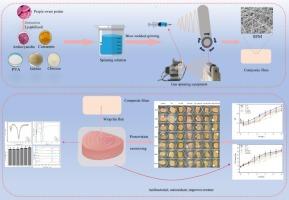金枪鱼皮明胶-多酚智能包装膜的制备及其在金枪鱼保鲜中的应用
IF 9.8
1区 农林科学
Q1 CHEMISTRY, APPLIED
引用次数: 0
摘要
为了解决水产品保存的挑战,本研究开发了一种利用天然色素的抗菌和反应特性的智能标签。采用吹风纺丝工艺制备了紫薯花青素和姜黄素的复合膜。明胶-聚乙烯醇-壳聚糖互穿聚合物网络显著提高了薄膜的性能,包括疏水性(水接触角:102.8° ± 1.56°)、热稳定性(峰值吸热:123 °C)和断裂伸长率(应力:1.18 kg/mm2,染率:43 %)。该膜通过协同机制延缓了金枪鱼的腐败:姜黄素破坏了细菌生物膜的完整性(细菌总数减少了3.37 log CFU/g),抑制了脂质氧化,而姜黄素/花青素复合膜(GC-CR/ATH)将肌红蛋白含量降低到21.8 g/s,延缓了褐变。pva掺入的GCP-CR/ATH膜通过“抗菌-抗氧化- ph响应”协同作用,优化了活性化合物的缓释,并保持了鱼的质地(弹性:0.42 mm,硬度:12.5 N)。本研究为水产品实时新鲜度监测和活性包装提供了理论支持。本文章由计算机程序翻译,如有差异,请以英文原文为准。


Preparation of tuna skin gelatin–polyphenol intelligent packaging film and its application in the preservation of tuna
To address aquatic product preservation challenges, this study developed an intelligent label leveraging natural pigments' antibacterial and responsive properties. A composite film integrating purple sweet potato anthocyanins and curcumin was fabricated via blow-spinning technology. The gelatin-polyvinyl alcohol-chitosan interpenetrating polymer network significantly enhanced film properties, including hydrophobicity (water contact angle: 102.8° ± 1.56°), thermal stability (Peak heat absorption:123 °C), and elongation at break (stress: 1.18 kg/mm2, stain: 43 %). The film delayed tuna spoilage through synergistic mechanisms: curcumin disrupted bacterial biofilm integrity (total bacterial count reduced by 3.37 log CFU/g), inhibited lipid oxidation, while the curcumin/anthocyanin composite film (GC-CR/ATH) reduced metmyoglobin content to 21.8 g/s and delayed browning. The PVA-incorporated GCP-CR/ATH film optimized sustained release of active compounds and maintained fish texture (springiness: 0.42 mm, hardness: 12.5 N) via “antibacterial-antioxidant-pH responsive” synergy. This work provides theoretical support for real-time freshness monitoring and active packaging in aquatic products.
求助全文
通过发布文献求助,成功后即可免费获取论文全文。
去求助
来源期刊

Food Chemistry
工程技术-食品科技
CiteScore
16.30
自引率
10.20%
发文量
3130
审稿时长
122 days
期刊介绍:
Food Chemistry publishes original research papers dealing with the advancement of the chemistry and biochemistry of foods or the analytical methods/ approach used. All papers should focus on the novelty of the research carried out.
 求助内容:
求助内容: 应助结果提醒方式:
应助结果提醒方式:


